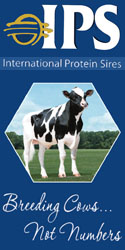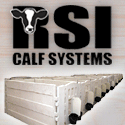 |
 |

|
|
|
South Dakota Ag News Headlines |
 |
2015-16 Dakota Performance Ram Test Results Available
South Dakota Ag Connection - 05/04/2016
Results from the 2015-2016 Dakota Performance Ram Test can be found on the NDSU Hettinger Research Extension Center.
The 2015-16 Dakota Performance Ram Test sponsored by participating sheep breeders, NDSU Hettinger Research Extension Center and SDSU Extension, was established to evaluate economically important wool traits and growth performance among young
ram lambs under a central test format.
"Commercial producer and seedstock producers recognize the value in purchasing superior studs to improve flock return from both lamb and wool," said David Ollila, SDSU Extension Sheep Field Specialist.
Using phenotypic and genetic selection tools, including index data from a central performance test like the Dakota Test can improve the accuracy of sire selection to pursue flock performance goals, OIlila explained.
"Commercial producers have the opportunity to knowingly maintain or improve the traits of the ewe flock by developing replacement ewe lambs that possess performance potential through the sire's genetic line," he said. "Seedstock producers have additional
data to aide in selection of stud rams that can supply heritable traits that best represent the breed."
Additionally, Ollila said the performance information can be used to develop Estimated Breeding Values (EBVs) through the National Sheep Improvement Program (NSIP). EBVs provide information about the potential for highly desirable traits to be passed to
the ram's progeny.
"The accuracy of the EBV will improve as the sire's progeny demonstrate the passage of these traits through their performance and will continue to reaffirm the performance merit of the ram," Ollila said.
In 2016, a number of Columbia and Dorset breeders participated in the test with the intent of developing performance data to support evaluation of those economically important traits within their breeds.
With this test structure, environmental factors, including plane of nutrition are standardized, therefore measured trait differences can be attributed to the animals' genes.
The Dakota Fall Ram Test has adopted the evaluation procedures approved by the American Rambouillet Sheep Breeders Association for individual traits and the formula to compute composite index values.
To initiate the test, rams are inspected for soundness, weighed, and identified.
Although the test is 140 days in length, ram weights are recorded every 28 days. Average daily gain for the entire test is calculated from the initial and final weights.
Scrotal circumference is measured on day 140.
"Economically important wool traits, considered important to the industry, and included in this test, are grease and clean fleece weight, fiber diameter, staple length," Ollila said.
Rams are sheared on day 0 and day 140 of the test. Fleeces are weighed from the final shearing and weights adjusted to an annual basis.
Staple length is adjusted to reflect a 365-day growth period as well and is determined by using the average measured fiber length at the shoulder, side and britch prior to shearing, 1/8-inch is subtracted to account for initial shearing stubble.
According to the recommendations from the American Rambouillet Sheep Breeders Association certificate of merit program, a committee of producers and research personnel place subjective scores on each ram for inferior wool traits, especially belly wool,
degree of face wool cover and skin wrinkles.
Following shearing each fleece is cored to obtain samples for laboratory analysis at Texas A&M University to determine fiber diameter, fiber variability, and clean wool yield.
Carcass merit is determined at the end of the test using ultra-sound measurements of fat thickness and rib eye area at a specific anatomical location, the 12th and 13th rib.
Fat thickness provides insight on the maturity development of rams with those having a greater fat thickness considered faster maturing animals.
"Rib eye area is an indicator of overall muscling and supports industry objectives to improve carcass quality characteristics," Ollila explained.
The American Rambouillet Sheep Breeder's Association has developed a genetic selection index that combines specific wool traits and growth performance (excludes carcass traits) into a single composite value.
Based on the index values the genetically superior individuals can qualify for recognition as Certified Rams. An index ratio is also computed to allow direct comparison between individual ram's within a breed on test.
As shown in the 2015-16 Dakota Performance Ram Test Final Report on the NDSU Hettinger Reseach Extension Center page, the top 30 percent of registered Rambouillet rams as indicated by the index are eligible for "Certified Ram Classification," in the
American Rambouillet Sheep Breeders Association.
In addition to the indexing requirements, a ram must meet acceptable standards for the following subjectively measured traits: degree of body skin folds, freedom from anatomical weaknesses and wool defects, including extremely hairy britch or excessive
amount of belly type wool.
All certified rams must have a minimum of 4.0 inches staple length, 9 pounds of clean wool, a core wool grade of 23.77 or less micron fiber diameter, a maximum of 2.7 face cover score, and must have gained at least .55 pounds/day on test.
For more information on selecting livestock, evaluating performance data, the National Sheep Improvement Program and Estimated Breeding Values contact:
Dave Ollila, SDSU Extension Sheep Field Specialist by email; Dr. Jeff Held, SDSU Extension Sheep Specialist by email or Dr. Chris Schauer, Director NDSU Hettinger Research Extension Center by email.
Other South Dakota Headlines
|
|
 |


|
 |
|
Copyright © 2024 - Farms.com. All Rights Reserved. |
 |
|